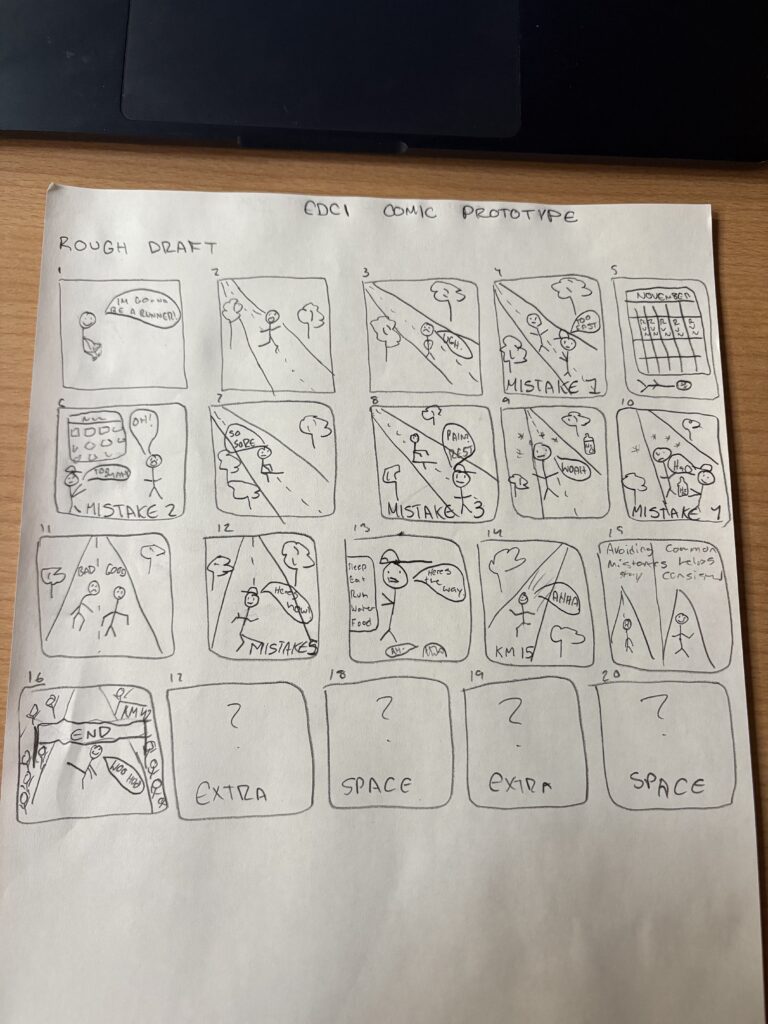Title: “Building Endurance”
Updated: September 19, 2025
Authors: Charlie Olney
Intro:
I chose to create an educational comic to teach readers about endurance training, specifically running. This topic stuck out because it is something i’ve recently been very interested in and many people, including myself, can feel lost when starting fitness and endurance training routines. Using a comic can simplify common mistakes with visuals and storytelling, causing the knowledge to become more memorable. The goal is to help beginners understand endurance running basics and motivate them to start smart. This comic also allows me to explore multimedia storytelling as a learning tool using a subject i’m passionate about.
THE PROCESS
Phase 1: Understand (Discover, Interpret, Specify)
THE CHALLENGE:
New runners often start with enthusiasm but regularly fall into common mistakes that lead to injury, burnout, or frustration. These individuals need guidance to train safely and consistently.
CONTEXT AND AUDIENCE:
- Typical audience: The typical audience for this comic is beginners in running, generally between the ages of 18 and 35. People who want to build endurance for health, enjoyment, or to prepare for races and other competitive goals.
- Specific cases: There are more specific cases within this audience. One example is someone who has never run before and feels uncertain about how to begin. Another is a highly motivated but impatient runner who pushes too hard too soon and risks injury or burnout.
- Needs: These runners need simple advice that breaks things down clearly. They benefit from seeing common mistakes to avoid and from encouragement to progress at a steady, safe pace.
- Motivations: Their motivations are varied. Many want the physical health benefits of running, such as better fitness and a healthy weight. Others are motivated by mental well-being, including reduced stress and greater happiness. Running also supports personal growth in other areas of life by building discipline, confidence, and resilience through setting and achieving challenging goals.
- Barriers: Beginners face barriers that can get in the way of progress. Injuries are a major obstacle, as are poor habits related to hydration, running form, and recovery. A lack of patience often makes these challenges worse, leading many new runners to stop before they see long-term results.
POV STATEMENT:
A beginner runner needs clear, practical guidance on endurance training so they can avoid mistakes, stay healthy, and build long-term running success.
LEARNING OBJECTIVES:
Main objectives:
- Explain what endurance running is and why it matters.
- Identify common mistakes beginner runners make.
- Provide safe, effective training principles to follow.
Sub-objectives:
- Teach the importance of pacing, fueling, hydration, and recovery.
- Highlight the role of form and strength training.
- Encourage patience and consistency over quick gains.
Phase 2: Plan (Ideate, Sketch, Elaborate)
IDEATION:
I brainstormed a list of common running mistakes based on my own personal experience, these include running too fast, increasing mileage too quickly, ignoring recovery and improper fuel/hydration. From there, I decided to structure the comic as a short journey that follows a new runner who struggles at first, learns important lessons along the way, and gradually improves. The overall tone will be relatable, encouraging, and realistic so that readers can see themselves in the story and feel motivated to apply the lessons to their own running.
SCRIPT (Draft):
- Panel 1: Beginner runner character laces up shoes, says confidently, “I’m going to become a runner!”
- Panel 2: Shows beginner runner start sprinting.
- Panel 3: Gets exhausted, holds side, says, “Why do I feel so exhausted?”
- Panel 4: Friend (an experienced runner) appears and states: “You’re starting too fast.” Show mistake 1: Running too fast too often. Explanation: Beginners should build an aerobic base with easy runs before overwhelming they’re body with hard/fast runs.
- Panel 5: Visual: Calendar with too many miles stacked in one week showing beginner runner exhausted and broken.
- Panel 6: Friend provides tip: “You’ve been adding to many miles, use the 10% rule for safe progression!”. Show mistake 2: Increasing training volume too quickly. Explanation: New runners who ramp up volume too fast are especially vulnerable to injuries, because their bones, tendons, ligaments, and muscles haven’t yet been conditioned to withstand the impact of runnin
- Panel 7: Visual: Runner holding shin/knee, says “Why am I so sore all the time?”
- Panel 8: Friend states: Text: “Any good training plan includes rest days too.” Mistake 3: Ignoring pain. Explanation: Ignoring pain while running can turn small issues into serious injuries. Listening to your body and resting early helps prevent setbacks and keeps you running consistently.
- Panel 9: Visual: Runner dizzy, water bottle in background.
- Panel 10: Friend: “Drink your water and eat carbs for energy.” Mistake 4: Poor fuelling/hydration. Explanation: Your body relies on carbs for energy and fluids to regulate temperature. Without them, you tire quickly, risk dehydration, and may feel dizzy or weak, making it hard to train safely or improve endurance.
- Panel 11: Visual: Slouched runner vs upright, efficient runner.
- Panel 12: Friend shares tips: Relax shoulders, midfoot strike. Mistake 5: Poor form. Explanation: Poor running form increases stress on muscles and joints, causing fatigue, pain, or injury over long distances. Efficient form helps conserve energy, maintain endurance, and reduce the risk of overuse injuries.
- Panel 13: Friend explains: “Endurance isn’t built overnight. Run slow, increase mileage gradually, fuel well, and rest.”
- Panel 14: Runner follows advice—shows progress: runs longer with a smile, feels strong.
- Panel 15: Side-by-side: old frustrated runner vs new happy runner. Text: “Avoiding common mistakes helps you stay consistent.”
- Panel 16: Runner finishes marathon smiling: “I did it the right way!” Closing message: “Train smart. Build endurance. Enjoy the run.”
SKETCH
My prototype is below. (Drawings not the greatest)

PRINCIPLES:
- Multimedia Principle: Use visuals (bad vs good running) with short (easy to understand) text.
- Coherence Principle: Only include relevant tips; avoid clutter.
- Segmenting Principle: Each panel highlights one mistake or principle.
- Personalization Principle: Use casual dialogue between characters.
- Contiguity Principle: Place text directly beside illustrations of mistakes/corrections.
Peer Feedback:
Coming soon…
